#ronin icon
Explore tagged Tumblr posts
Text

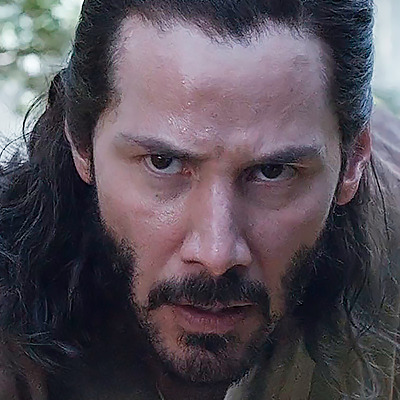
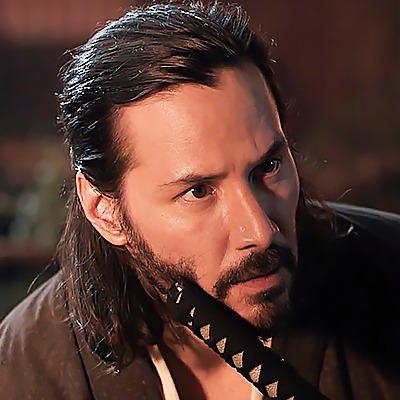
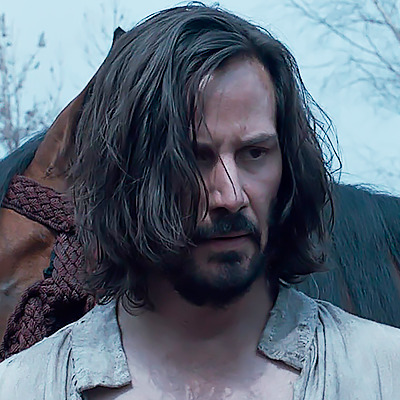
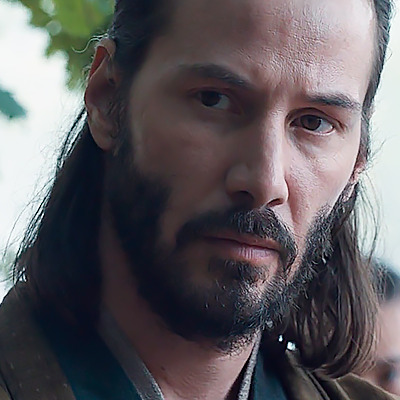
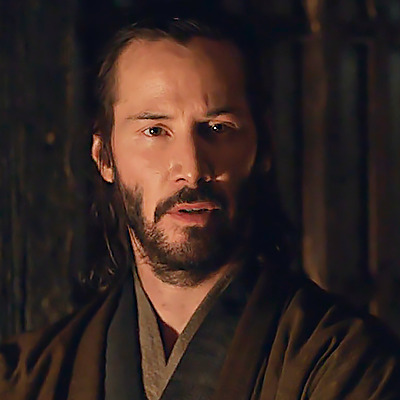


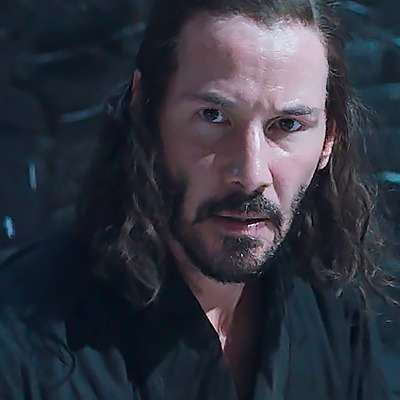
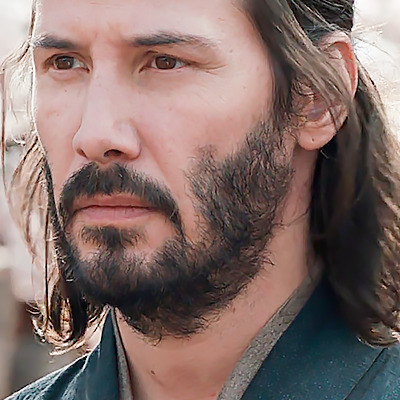


Kai - 47 Ronin, 2013
#47 ronin#keanu reeves#kai 47 ronin#kai icons#47 ronin icons#keanu reeves icons#icons#icon#twitter icons#random icons#icons without psd#filmedit#moviedit#films icons#movies icons#film icons#movie icons
136 notes
·
View notes
Text
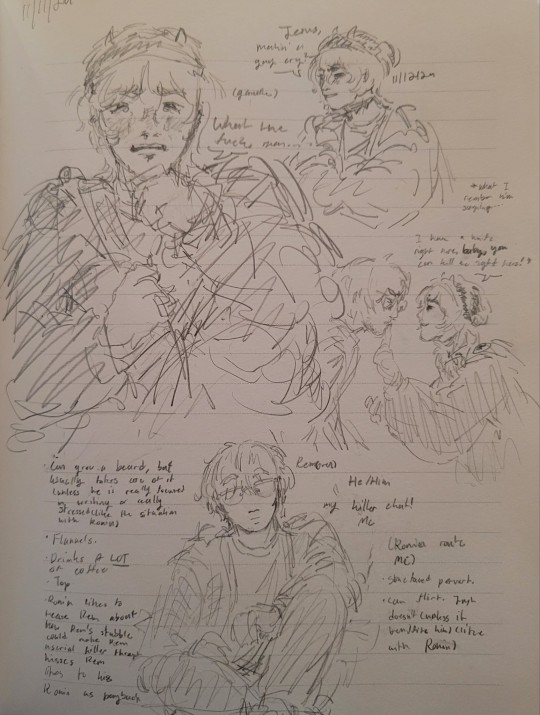

RAHHHHHHHHHHH.
#guys. gIs.#what if. i made ocs. for every main killer chat route.#i first give you Rem. the Ronin route guy <<<<333334#total loser but smart at what he does.#think of him like a possum.#(rem is short for remora. yk the fish that likes to eat parasites and guck off of sharks?#i may explain my reasoning for naming all my mc ocs after remoras in a different post... anD ITS NOOOT#JUST BECAUSE I LIKE SHARKS. OKAY. AND THAT I ASSAIGNED EVERY KC! CHARACTER A SHARK.#it may be. a reason. but noooot hust because i swear 😣😣😣)#killer chat!#killer chat#ronin killer chat#ronin beaufort#angel killer chat#v killer chat#misaki killer chat#mc oc#oc#idk if i should tag this as oc x canon 😭#ig it is??#oc x canon#just in case 🫡#my art#next up: draw luca and feli cause me and my boyfriend need more than just their icons to match pfps with 😭😭
21 notes
·
View notes
Text















⠀⠀♥︎ ≀ tadanobu asano icons !!
#tadanobu asano#icons#spirit icons#120x120#icons spirit#layouts#packs#asano#shogun#movies#actor#47 ronin#kashigi yabushige
38 notes
·
View notes
Text
character pride icons pt. 61: misc. animation (again again again!) pt. 3
queer headcanons

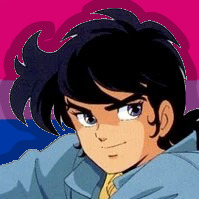
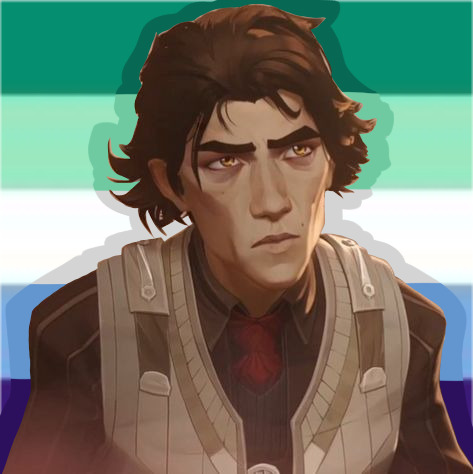
wirt (over the garden wall) - transgender | ryo sanada (ronin warriors) - bisexual | viktor (arcane) - gay



jay walker (lego ninjago) - bisexual + transgender

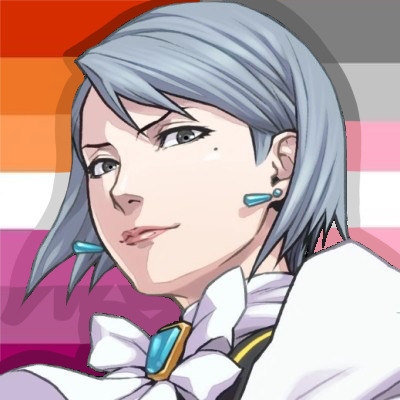
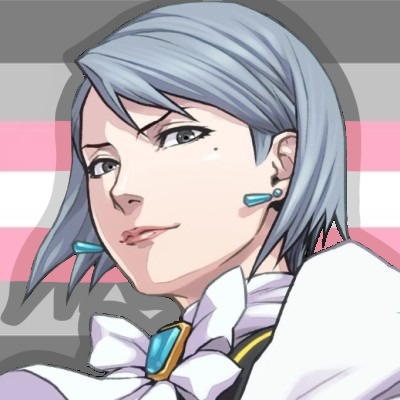
franziska von karma (ace attorney) - lesbian + demigirl

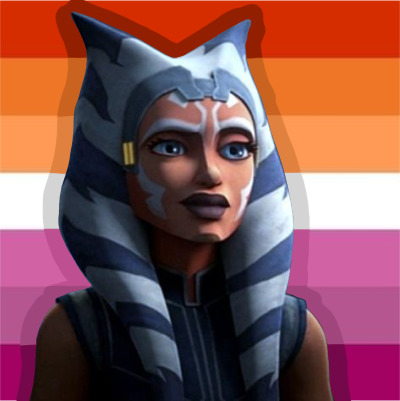

sabine wren (star wars) - lesbian | ahsoka tano (star wars) - lesbian, aroace
bonus! pride flags color-picked from the characters




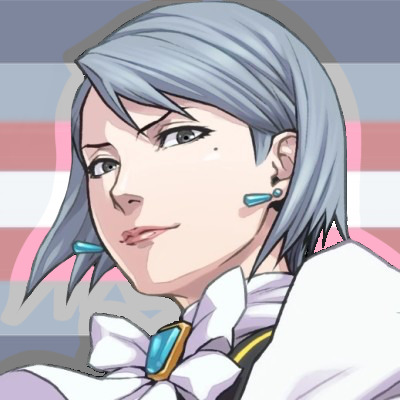
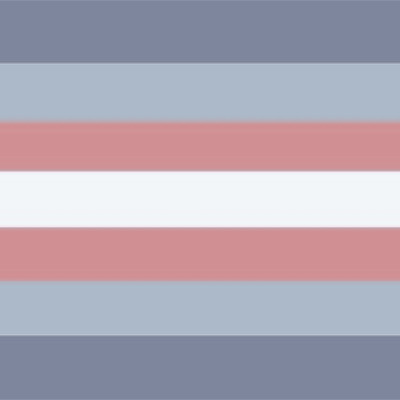
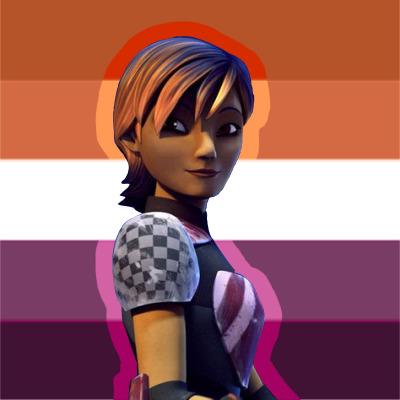

feel free to use these for any non-commercial purpose, as long as proper credit is given!
if you'd like to see a different combination of character + flag, my ask box is always open for requests
#icons#pride icons#character icons#pride flags#queer characters#queer#star wars#over the garden wall#ace attorney#lego ninjago#ninjago#arcane#leage of legends#ronin warriors#transgender#trans#bisexual#bi#gay#mlm#achillean#lesbian#wlw#sapphic#demigirl#demigender#bigender#agender#nonbinary#aroace
54 notes
·
View notes
Text

Last Ronin by Gabriele Dell'Otto
36 notes
·
View notes
Photo










Welp! Like I said, heres some tmnt icons. In order, its Leonardo, Michelangelo, Raphael, and Donnatello, Venus de Milo, Lita, Jennika, Ronin Mikey, Kirby (A turtle design that never made it to canon), and Lita where she has a white mask (but isnt albino, sadly, so it isnt washed out or lost).
#tmnt leonardo#tmnt donatello#tmnt michelangelo#tmnt raphael#last ronin#tmnt kirby#tmnt venus#rottmnt jennika#tmnt lita#r196#free to use#bts icons#reddit refugee
110 notes
·
View notes
Text

A carved and hollowed out chest. A determined spirit.
#Genshin Impact#Kaedehara Kazuha#WIP#possibly an icon for smth#what widow syndrome does to a ronin#or losing everything pretty much
11 notes
·
View notes
Text

[ID digital icon drawing of ronin ninjago with the aromantic and the 9-stripe Gilbert Baker flag behing him]
hehe old man.
#ninjago#ronin ninjago#b.text#super love how he turned out!!!!! reaally wanted a good ronin icon#but didnt feel like editing a screenshot. again. and wanted he with some grey hair soooooo#babygirl <3
37 notes
·
View notes
Text
Eh fuck it *Edits blog theme in the middle of being a little bit obsessed with a lego ensuring his face will be on my blog for like the next 4 years till i eventually update the theme again*
#this is just like my theme before last which had the little ninjago icons and ronin in the corner for like 5 years#it always comes back to legos#not that anyone looks at the themes but in case they do. my last one was kinda broken it needed a quick update#you couldn't like. click on posts. idk what was up with it#talk
7 notes
·
View notes
Text

“You should have killed me right here, old man!
You could’ve put me out of my misery long ago!”
#*sobs*#I think abt spirit world Ronin faaaar too much#and that transformation scene in book 4 where they’re carrying all of their dead friends?? chills. iconic. we stan self growth#samurai of hyuga#SoH#choice of games#hosted games#interactive fiction#cog#devon connell#my art#hg
11 notes
·
View notes
Text












Chikara - 47 Ronin, 2013
#chikara#chikara icons#jin akanishi#jin akanishi icons#47 ronin#kai icons#47 ronin icons#icons#icon#twitter icons#random icons#icons without psd#filmedit#moviedit#films icons#movies icons#film icons#movie icons
19 notes
·
View notes
Note
So a genuine question (or two)
1. I want to write a fanfic about mc's "first" date with Ronin and after talking about it with other people in discord I came up with an idea. I want the date to be made of two parts (both organised by Ronin because it would be his idea to begin with kinda) and I want to know your opinions since you know the character better than anyone. The actual question here: is that date really a good idea for Robin?
So the first part of the date - Ronin would take MC for apple picking and then he would make them bake him an apple pie because he's an icon like that ( he would offer to help with the chopping lol)
The second one - it would be late at night and our lovely serial killer would take mc to his favourite massacre alley, he would kill someone (probably a random unlucky person) and then he would wrap his arm around mc's waist (he would be standing behind them so his head would be on their shoulder (he would have to lean down lol)) while he would hold a knife in his other hand and he would whisper in their ear "now, curve out the aorta like you said you would" just a little corruption here and there.
The second question is:
What would the li do if someone kidnapped their poor little MC? Would they look for us or would they be like: nah it's not my problem.
Love Ur game!!! And characters!!!
i think that would be super cute! and would be an adorable first date idea (especially forcing the mc to make him an apple pie, help) + the murder corruption after is a cherry on top ;)
i love this question! all the li's would look for the mc, but how they do it is different:
angel - by day, she would do a broadcast in her channel about the mc being missing/kidnapped and pull strings to get it solved. by night, she'd go sniping: no one who values their life should fuck with her friends and certainly not her lover.
misaki - would freak out. and feel scared like, "is this happening to mc because of me??? do i drag them down??? oh no..." but after a bit of pep talk she's right on the action. the kidnapper will never see them coming <3
v - finding you is now his first priority. forget crime: you're the most important person to him. and his animals now have a tasty meal to look forward to...
ronin - probably the one to kidnap mc tbh and fuck with them. (jokes aside, ronin would figure out who the kidnapper is, but let mc freak out a little until they believed they were actually dying, before coming in like the grand old saviour he is. asshole <3)
64 notes
·
View notes
Text
Mizus Gender
He/him they/them she/her pronouns for Mizu

I know the writers of the show wrote blue eye samurai with Mizu as a woman disguised as a man in a way similar ish to Mulan but uh
They accidentally made it deeper than that ??
If you removed like 2 lines of dialogue in episode 5 you could even make an argument for trans masc Mizu. Or at the least gender queer.

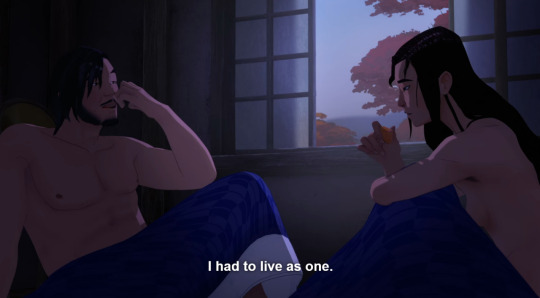
Being transgender is not a concept in this time period. But trust. People have always wanted to be other genders, probably for the entirety of human history. And how someone would go about being trans in a world with no true understanding of the concept, might be similar to what Mizu IS DOING RIGHT NOW.
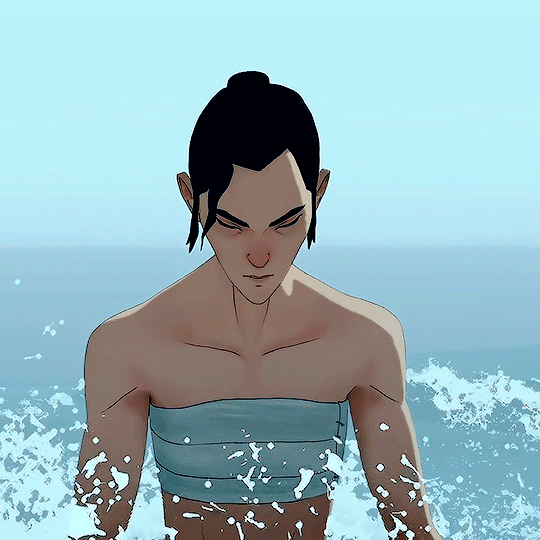
Living as a man. PERMANENTLY. Not temporarily to achieve some near goal like Mulan and the many other stories with this concept. Mizu has lived as a man nearly their entire life and no intention to ever live as a woman in the future.
Mizu admires their freshly binded chest in the mirror as a teen.
When alone Mizu refers to himself as a man.
When alone with Ringo, (someone who knows the secret) Ringo also refers to Mizu as a man.
Mizu threatens to straight kill Ringo at the the very use of the word “girl”.
When, and ONLY when seeing 2 MEN kiss does he think of Taigen.
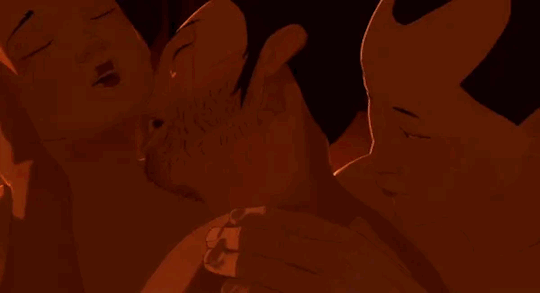
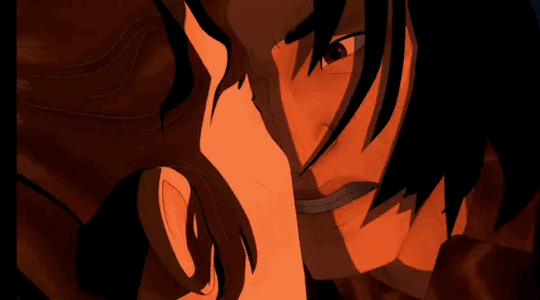
Not to mention madame Kajis indelicate insinuation of gay sex to Mizu, something I believe wasn’t for no reason. OR Madams iconic line “you are more man than ANY come through my door” (I’m convinced she has an idea of Mizus true sex but doesn’t care to accuse or call them out for it)
They HAD lived as a woman in the past. Only for about a year, and they did it to get married for her mothers sake. To save her from a life of prostitution. She was able to be happy, because it IS POSSIBLE to be happy while not presenting how you like. It’s a strain and some can never be happy doing so but it’s possible and people do it all the time to make their lives easier or to keep the peace with family or for many other reasons.
Episode 5 gave HUGE VIBES of going back into the closet when living with your parents or just visiting. And Mizu looked SO uncomfortable and awkward in woman’s clothing and doing “wife things” (partly cause they have never done that before) and maybe it was my own projecting but I felt so uncomfortable FOR Mizu.
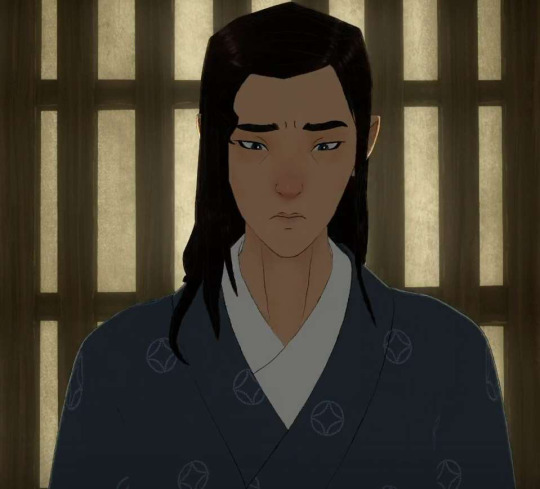
These things don’t necessarily mean being a transgender man specifically. Gender is actually really complicated and has ALOT to do with what society deems it.
Mizu is a masculine person. Being what Japan wants women to be isn’t in line with what Mizu is. A violent, practical, stoic, cold, masculine, confident and capable warrior.

dressing up as a woman with the makeup ONLY to try and make her husband happy. She didn’t WANT to. “To soften her husbands heart, the bride… danced” performed femininity FOR HIM. Only for Mikio to betray her for, in his eyes, being more masculine than him, by beating him in a physical fight.
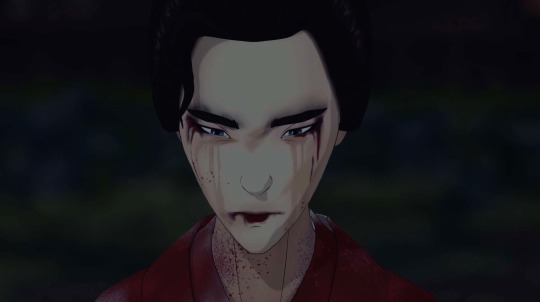
Mizu is both the ronin and the bride. Mizu will be whatever they need to in order to achieve their owed deaths. They HAVE to be a man to get their revenge but that doesn’t mean Mizu WANTS to be a woman. (To be fair who WOULD in that time but I digress) and it doesn’t mean they WANT to be a man. They WANT their revenge. Everything is secondary to that.
Mizu is so different from other characters…
I grew up in a kinda misogynistic place and my mom really didn’t let me “do boy stuff” or dress masculine in any sense until my late teens. I my self don’t know if I can even call myself Trans. But I’m masculine, I like looking like a man and dressing as one but I don’t WANT to be a man necessarily. But I don’t WANT to be a woman. I feel like we as a society put to much distinction between the two and the people who don’t fit either side get left out at times.
Mizu is such a relatable character to me, like no other characters complicated feelings about their own sex and gender have ever come close.
They are for those who don’t have a strong sense of their own gender. Especially those who are biologically female and hesitant to lean into their sex because of the societal baggage.
Once people realize that how you dress, how you act, and what you do in reality have nothing to do with your bio sex and everything with what society has forced people to do based on factors out of our control is the day we can finally stop having these conversations.

Do what you want, gender is fake.
But Mizu is forever 🫶
#blue eye samurai#mizu blue eye samurai#bes#mizu#mizus gender#there’s so much more I want to say but I’ve already put out a wall of text.#I WILL block if you come in here with a “nuh uh 🤓#i would write more about her as a woman but I just revolves someone else’s big wall of text about that#read it if your interested they were much better worded than I#he/him bisexual lesbian man
124 notes
·
View notes
Text
here is the post where the future will see how absolutely UNDERRATED hiroyuki sanada is.
He should've been famous or at least as recognized like 10 or 20 years ago.
This man was in two marvel movies, one was in X Men with Hugh Jackman, and one in Endgame but his character was there to be killed by Hawkeye but still. Go sword fighting!!
He was also in Rush Hour(aka the most badass and iconic movie trilogy ever) with Jackie Chan and Chris Tucker. Also in a movie w Brad Pitt (Bullet Train), in two movies w Keanu Reeves (47 Ronin, John Wick), ALSO w Tom Cruise (The Last Samurai and if I'm not mistaken there's one more but I forgot), he was also in a movie w Jake Gyllenhaal and Ryan Reynolds(Life).
He deserved all those roles, and he was in so so many big movies, yet he is still so underrated. Man is 60 years old, moving and swinging his sword faster than anyone his age, trust me I'm not even 20 and I'm having back pains just by standing for 30 minutes. A phenomenal actor, very handsome, amazing chemistry with all of the actors he works with, also very sweet and humble. No controversies or dramas.
#this is a sign for everyone TO STAN HIROYUKI SANADA#hiroyuki sanada#actors#rush hour#bullet train#the last samurai#47 ronin#john wick#john wick 4#koji shimazu#kenji#brad pitt#jake gyllenhaal#ryan reynolds#tom cruise#hugh jackman#jackie chan
140 notes
·
View notes
Text
Ahsoka Episode 6 “Far, Far Away”: The Story, the Symbolism, and the Score
Episode 6 of Ahsoka begins with the sound of distant purrgil calls as Ahsoka and Huyang travel through hyperspace, crossing the void between galaxies. During their discussion of the tales Huyang used to tell the Jedi younglings there is no music.


I loved that Huyang said such an iconic line in this episode, reminding us that this is indeed a fairy tale, a children’s story.
The Title Card for Ahsoka appears, and then the episode title, “Far, far Away.”
We hear ominous music when Sabine is in the brig onboard the Eye of Sion. The window to her cell is shaped like an upside down triangle.
The sinister music continues during the scene with Baylan, Shin, and Morgan on the bridge. Morgan’s Theme (the Nightsister theme) is heard when the Eye of Sion exits hyperspace.
The line “Peridea is a graveyard” reminds us that this is indeed a “descent into the abyss” a stage of the hero’s journey which I have discussed on this blog before. Ominous music plays here.
The characters who are aligned with the dark side are on a quest for more power to dominate others. They have followed the Path to Peridea as a kind of path to perdition as I have mentioned in my previous metas. But Sabine, our heroine, is descending into the Underworld on a more noble quest. She hopes to find her beloved Ezra Bridger, echoing the story of Orpheus, the hero of Greek myth who descends into the Underworld to find his beloved Eurydice.
Morgan’s Theme continues when they board the shuttle and descend to the planet Peridea.
The landscape of J. R. R. Tolkien’s Middle-earth is suggested by the giant statues and the Nightsister fortress, which resembles an evil version of Minas Tirith.
The characters encounter three Nightsisters, analogous to the Three Fates of Greek mythology, the Moirai. (Note the similarities between this word and the name of Ahsoka’s owl, Morai, a creature I predict that we will be seeing again soon.)
The three Fates were the personification of destiny in Greek mythology. The three sisters were known as Clotho (the spinner), Lachesis (the alotter), and Atropos (the unturnable, a metaphor for death). The end credits for this episode name these three Nightsisters as Klothow, Lakesis, and Aktropaw, clearly indicating the intended symbolism of these three characters. As George Lucas said back in the late nineties, “Well, when I did Star Wars I consciously set about to recreate myths and the — and the classic mythological motifs. And I wanted to use those motifs to deal with issues that existed today.” (From billmoyers.com) Lucas’ apprentice, Dave Filoni, has learned this lesson from the master himself.
The music is quieter in this scene, with sounds of low vibrations being heard. Morgan’s Theme continues when Sabine is imprisoned by the Nightsisters’ three orbs, which held her bound within a triangle made of red cords of energy.
Outside of the fortress three wolf-like creatures howl as ominous music plays. Choral music suggesting the mysticism of the fallen Jedi Order is heard as Baylan speaks of Peridea being a realm of “dreams and madness” from old “children’s stories come to life.” Once again, the viewer is reminded that we are being told a fairy tale, a myth. The musical score subtly teases the listener with three notes from Ahsoka’s Ronin theme in this scene.
Sabine is imprisoned inside the Nightsister fortress as the Chimaera arrives with the sound of ominous metallic rumbling. Thrawn’s flagship Star Destroyer was named after the female fire-breathing monster in Greek mythology which was part lion, part goat, and part dragon.
I am no Freudian, but the Chimaera’s open docking bay hovering over the phallic tower of the Nightsister fortress seems to be the most overtly sexual symbolism I have seen in Star Wars in a long time. However, I’m not here to discuss that visual metaphor.

Organ music which anticipates but does not present Thrawn’s theme is heard as the Nighttroopers muster under Enoch’s command. These undead stormtroopers have cracked armor repaired with golden seams suggesting the Japanese art of kintsugi, as well as armor pieces bound with bands of red cloth. They are heard chanting “Thrawn! Thrawn!” as the Grand Admiral makes his dramatic entrance. For me this chant was reminiscent of how the orcs in Return of the King chanted “Grond! Grond!” when using their mighty battering ram against the walls of Minas Tirith. (You can do your own Freudian analysis of that scene. I’m not going there.) What was Grond?
“Grond, also known as the Wolf's Head, was a one hundred-foot long battering ram with a head in the shape of a ravening wolf, used in the arsenal of Sauron in the Third Age. Though named for Grond, Morgoth’s warhammer, it was created in the likeness of the Wolf of Angband, Carcharoth.”—from lotr.fandom.com
Creepy music accompanies the Nighttroopers as they transfer of cargo from the catacombs beneath the fortress. What is inside them? Dead Nightsisters, waiting to be revived by dark magic?
Thumps and low pitched sounds accompany Thrawn’s conversation with Baylan.
Thrawn speaks of Sabine’s desire to be reunited with her long-lost friend. (The word desire is a very intentional word choice, with the connotation that the connection between Sabine and Ezra has potential to be more than just friendship.)
Sabine: I’m sure he’s doing just fine.
Thrawn: You gambled the fate of your galaxy on that belief.
Sabine: You wouldn’t understand.
Thrawn: Perhaps not.
Evil does not understand love and loyalty. (See my previous post about the Path to Peridea.)
Enoch returns Sabine’s weapons to her, and she is provided with provisions and a wolf-like howler for a mount. He tells her to “die well” as she embarks on her “fool’s errand.”
The line about a “fool’s errand” calls to mind this scene from Tolkien��s novel, The Return of the King:
'Tell me,' he said, 'is there any hope? For Frodo, I mean; or at least mostly for Frodo.'
Gandalf put his hand on Pippin's head. 'There never was much hope,' he answered. 'Just a fool's hope, as I have been told…”
“A Fool’s Hope” was also the title of the penultimate episode of Star Wars Rebels final season.
Once again, Thrawn’s theme is only hinted at by the organ music at the end of the scene.
Sabine’s scanner is destroyed during her fight for her life with the red-armored bandits in the wastelands. Her life is saved by her Mandalorian armor and weapons, Ahsoka’s training, and Ezra’s lightsaber in this action sequence.
Baylan and Shin ride out on howlers. Nighttroopers load coffin-like cargo containers onto the Chimaera as uneasy music plays. Thrawn decides to dispatch only two squadrons of Nighttroopers. His disdain for Jedi, light or dark, is apparent: “It matters not whether Wren and Bridger are killed or stranded here. The same can be said for your two mercenaries.” Ominous music plays.
The scene with Sabine and the howler is accompanied by gentle music played upon wooden flutes. Sabine processes her abandonment issues and her complex feelings for Ezra in this scene by taking out her emotions on the howler. “You. You abandoned me. I should have known you are a coward.” She tries to make the howler stop following her, but the loyal animal comes back as soon as she walks away. “Okay. Fine,” she says. “I’ll give you another chance, but you better not bail on me this time.” The gentle flute music continues. A motif of ascending perfect fifths suggests Ezra’s Theme.
The howler stops to drink water and sniffs the air. The thing that Sabine and the audience assumes to be a rock is revealed to be a sentient little hermit-crab-like creature called a Noti. Gentle music plays when Sabine kneels, puts down her blaster, and extends her hand to the creature. The Noti recognizes the Rebel Alliance symbol (an evolution of her own Starbird design) on her pauldron. The creature has a medallion of his own, marked with a similar symbol.
“Do you know Ezra Bridger?” Sabine asks, touching her heart. “He’s my friend.”
Ominous music plays as Baylan and Shin discover the dead bandits. Once again choral music is heard when Baylan reminisces about the Jedi Order.
It is also revealed that the Nightsisters are fleeing from a power that is greater than their own.
Baylan and Shin see the red Bandits in the distance. “The enemy of our enemy is our friend,” says Baylan, “for now.”
Peaceful and noble sounding music is heard when Sabine sees the Noti encampment. She smiles at the mother Noti rocking her baby in a hammock.
With Sabine in the foreground, the camera pans to show a now adult, bearded Ezra Bridger wearing a red robe and leaning against the wall of his home. “I knew I could count on you,” he says as joyful music plays, music which features the piccolo, flute, and other woodwind instruments.
The closed captioning for this episode says that there is captivating music playing when Sabine and Ezra finally embrace. We hear a beautifully orchestrated rendition of Ezra’s Theme on the French horn with a new countermelody in the strings to heighten the emotional impact of this long-awaited scene.


Ezra’s Theme is heard again when he says “Sabine, thanks for coming. I can’t wait to go home.”
When we return to where the Chimaera is docked with the Nightsister fortress, a suggestion of Thrawn’s Theme is heard at a quick tempo suggesting the urgency of the situation that is about to unfold. Ahsoka Tano is coming. “The thread of destiny demands it” is a line that further emphasizes the three Nightsisters playing the role of the three fates. We finally hear Thrawn’s Theme presented in an obvious way as the episode ends.
I have blogged about the magnificent end credits music in previous blog posts, so this time I am going to discuss something different: the alchemical symbolism in Ahsoka.
The central focus of alchemy was to transmute base metals into gold and create the elixir of life, as any aficionado of the lore of the philosopher’s stone knows. The process is a metaphor for the purification and transformation of the human soul to a state of perfection.
Three colors symbolize this process, black, white, and red.
First there is the nigredo (blackening) stage of the alchemist’s work, representing the breaking of the human spirit. This is where both Sabine and Ahsoka are at the beginning of the series.
Second is the albedo (whitening) stage, which involves washing away impurities or vices, and being ready to grow and learn again. This is most clearly illustrated by Ahsoka the Grey’s “death” and transformation into Ahsoka the White.
Third is the rubedo (reddening) stage, which is where we are in the story right now. It represents the purified and awakened spirit reaching its highest and purest form.
“The symbols used in alchemical writing and art to represent this red stage can include blood, a phoenix , a rose, a crowned king, or a figure wearing red clothes.”—Wikipedia.
The color red, of course, is symbolic of Nightsisters and their magic in this series, as well as symbolizing the red thread of fate.
Baylan Skoll’s line about having to “destroy in order to create” is an example of the alchemical concept of “solve et coagula” meaning to separate then join together. Nothing new can be built without destroying the old. Perhaps this is really telling us about the destruction and rebuilding of the Jedi Order.
In the completion of the rubedo stage there must be a union of sulphur and mercury, also known as the wedding of the Red King (the sun) and the White Queen (the moon). Sulphur represents the masculine principle, the soul, and the fire of life. (Remember Ezra’s red robe?) Mercury represents the feminine principle and the mind, flexible and changing. (Sabine is a clever young woman who lives inside her head, sometimes too much. Lately she’s been distracted by her heart.) Mercury also represents a state that can transcend death.
Is the much-discussed Ezra and Sabine hug the union of Sulphur and Mercury? Or should we expect something more than that?
Much has been written about Baylan Skoll and Shin Hati as the mythological wolves who chase the sun and the moon. This episode ends with the pair in pursuit of Ezra (sulphur, the Red King, the sun) and Sabine (mercury, the White Queen, the moon). When Skoll and Hati catch the sun and the moon, Ragnarok begins.
Besides sulphur and mercury, there is another element present at the rubedo stage of alchemical transformation: salt.
Ahsoka the White is coming.
Please reblog and comment on what you think of my musical and literary analysis of this episode of Ahsoka. I am looking forward to reading your replies.
#sabine wren#ezra bridger#star wars#ahsoka series#sabezra#star wars rebels#ezrabine#ahsoka tano#thrawn#baylan skoll#shin hati#morgan elsbeth#nightsisters#chimaera#j r r tolkien#dave filoni#george lucas#kevin kiner#star wars music#fates#mythology#alchemy
201 notes
·
View notes
Text
Ahsoka Tano Leitmotif Analysis
"Over the years, I've made my share of difficult choices. Often, no one understood my reasons. Except my Master...He always stood by me. Even when no one else did. That's why no matter what happens next, I'm going to be there for you." Ahsoka Tano


A Jedi, a rebel, and a Ronin, Ahsoka Tano proves to be one of the most changed characters. One of the Kiner's first original themes in their many Star Wars soundtracks. There’s a good reason why it’s proven to be one of the most iconic themes in Star Wars on par with John Williams’s leitmotifs. As a result of both her amazing theme and her character growth, she's one of my favorite SW characters.
Ahsoka Tano is one of the most notable Order 66 survivors and Jedi Masters. She was let down by the Order she was raised to serve and left to find her own path. A survivor of the horrors of Order 66, she attempted to find peace but found out she couldn't lie in hiding. To this end, she created the first intensive intelligence network of the proto-rebellion, the Fulcrum Network. She struggles to deal with her legacy as one full of war and blood being the apprentice of the future enforcer of the Empire, Darth Vader once known as Anakin Skywalker. Yet, she survives all those tragic events, she perseveres so others don't have to undergo what she went through.
"There'll be no negotiating with the apprentice of Anakin Skywalker." Thrawn
Her theme invokes a sad, melancholy feeling that resonates with pride and power as Ahsoka's determination presents itself. The flutes echo a sense of tragedy and sadness Ahsoka is forced to witness from seeing the Clones become nothing more than droids and her former master being the face of evil. The flutes truly give haunting chills whenever I hear them. However, the orchestra goes into major key as they showcase Ahsoka's resolve and skill. No matter what happens, Ahsoka is a Jedi. I can't wait to see how S2 of Ahsoka will evolve her theme.
The variants of her leitmotif that best summarize her character are Ahsoka Leaves, Ahsoka Is Ready, Where the Sun Sails and the Moon Walks (the original ending music for the Rebnels S2 finale and personally I prefer it over It's Over Now, it's also reprised in Epilogue Part 2's ending), and Hyperspace Jump. Hyperspace Jump is the best variant of Ahsoka's theme (it's also mixed in a little with the Purrgils' theme) alongside Epilogue Part 2.
“This is a new day, a new beginning.” Ahsoka Tano
#star wars#music analysis#ahsoka tano#star wars ahsoka#leitmotif#Spotify#star wars ahsoka tano#sw ahsoka#ahsoka#my original post
28 notes
·
View notes